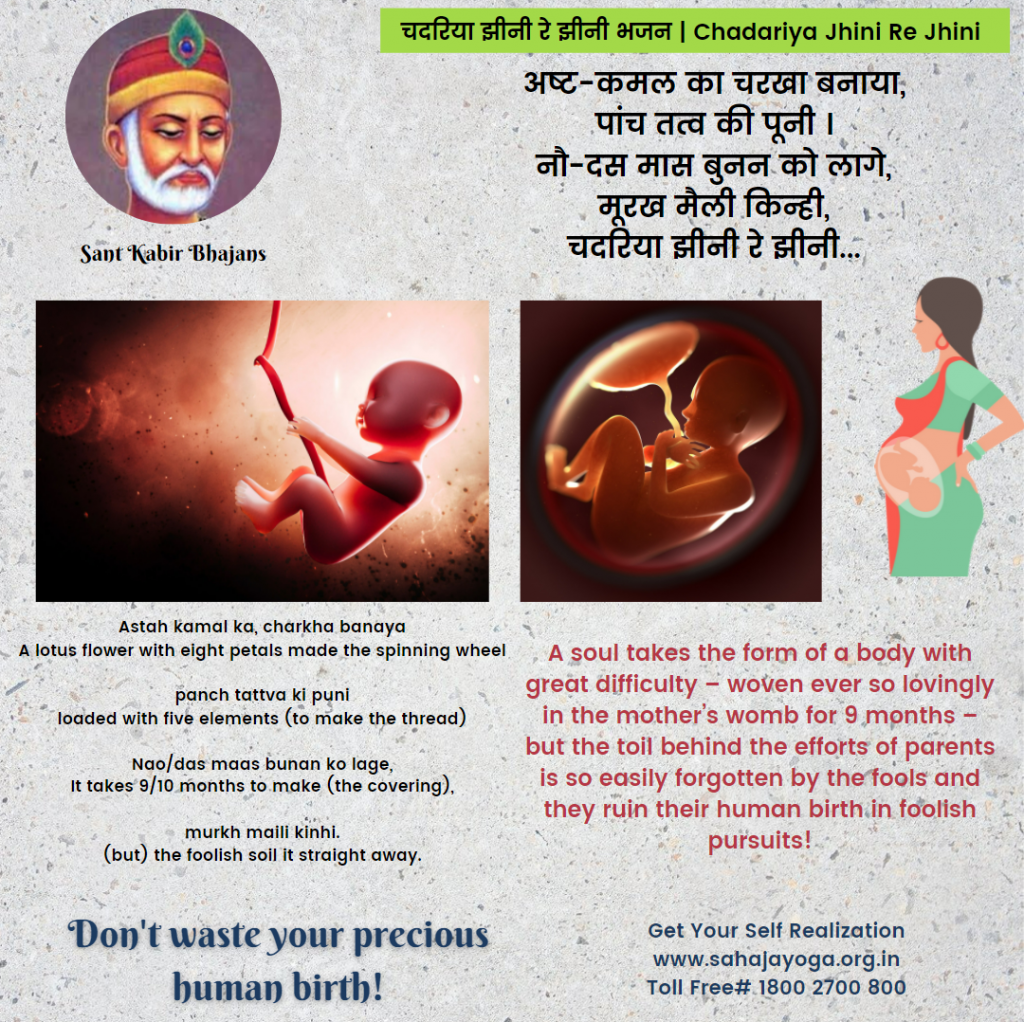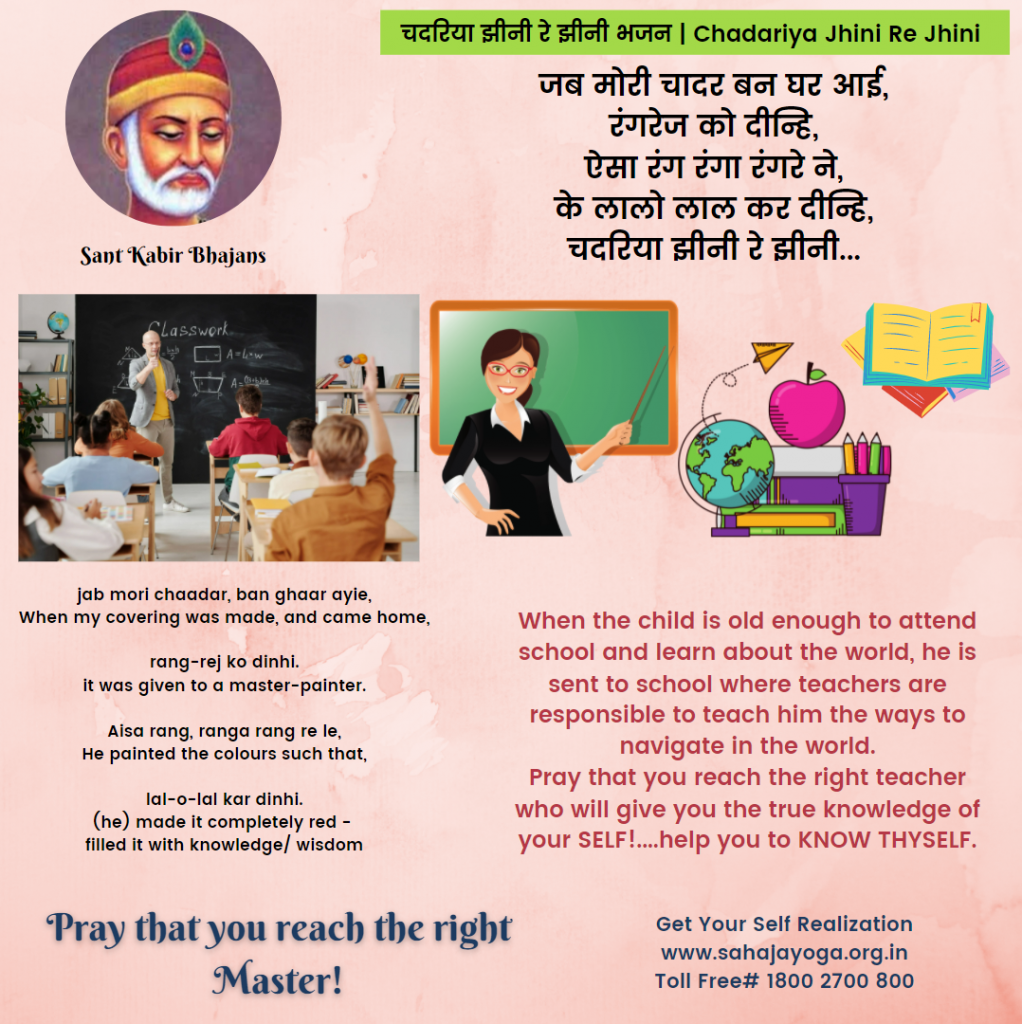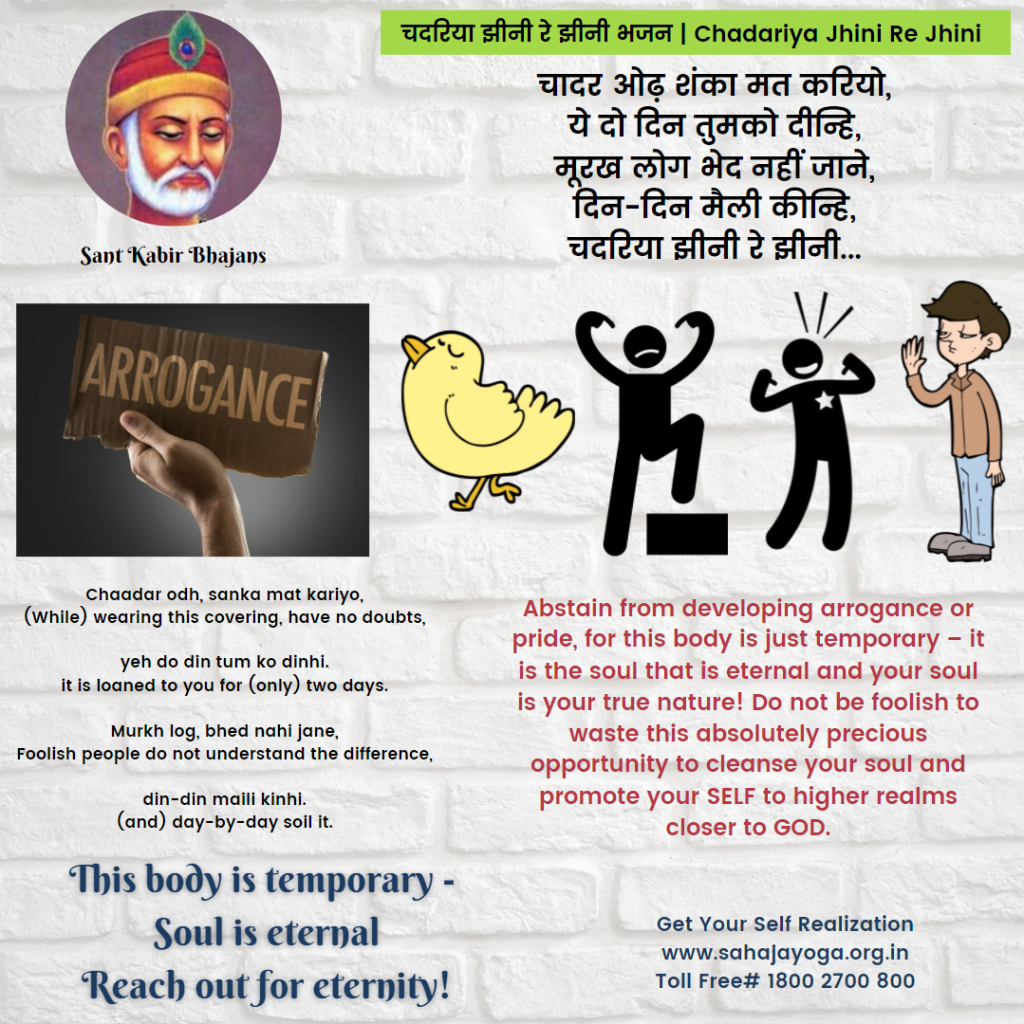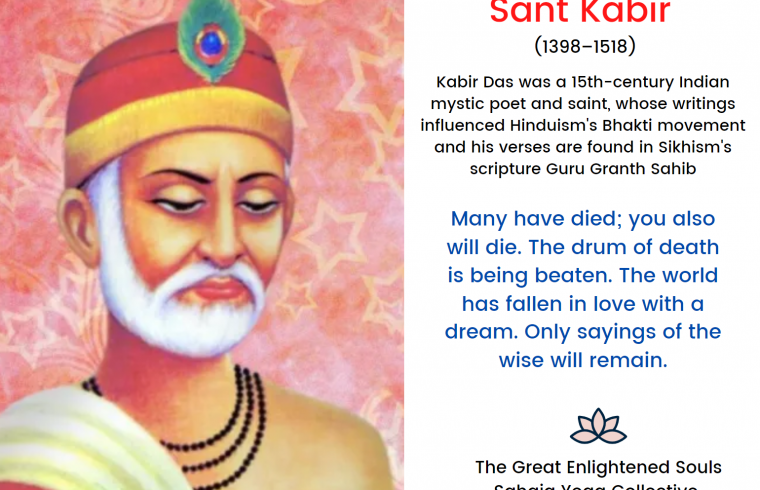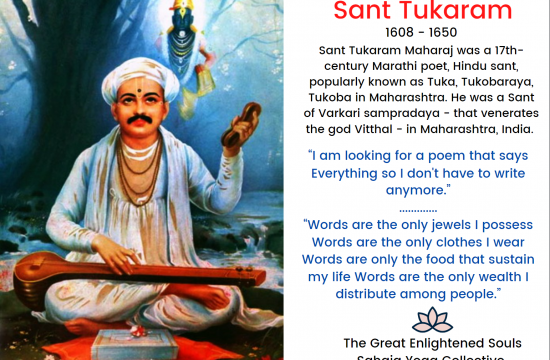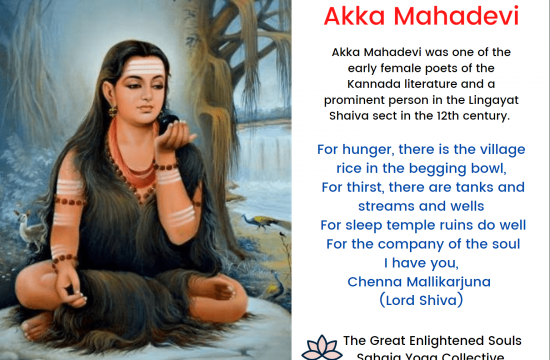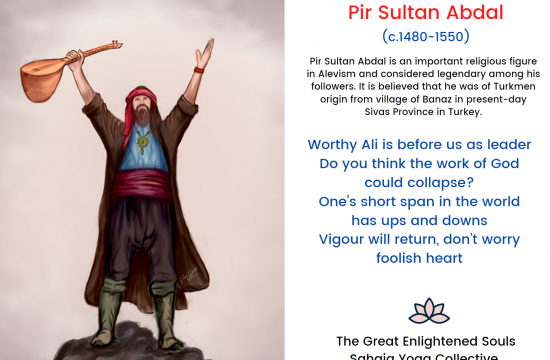KABIR
(1440-1518 A.D.)
In the far villages of Central India one can hear the humming of thousands of looms echoing the thoughts of Kabir between the knots of their weaves. These weavers are popularly known as Kabir Panthis or followers of Saint Kabir, who himself was a weaver. Perhaps God lives closer in the hearts of simple
devotees who do not rationalize him but ensconce him in their hearts. When evening comes they thank him for his blessings, and rejoice in the abundance of their paltry earnings. But they pour out the richness of their soul in the most intricate brocades that evoke the awe of queens. The skill and art of generations
pass through their deft fingers expressing the joy of their devotion. Kabir was one such joyful weaver who lived about four hundred years ago in the holy city of Varanasi.
Once, sage Narada prided himself to be the greatest devotee of Lord Vishnu. Lord Vishnu wanted to test him, and asked him to visit another great devotee who was tilling his field. Narada went the farmer and observed him very critically. The farmer woke up at the crack of dawn, took the name of Lord Vishnu and
then toiled hard at the soil. He returned at dusk, thanked the Lord for his frugal meal, and bundled to sleep. Narada found nothing great in him, and conveyed his doubts to Lord Vishnu. Lord Vishnu directed Narada to carry a cup of oil filled to the brim around the city without spilling a drop. Narada walked around the city attending carefully to the cup of oil and returned without spilling a drop of oil. Lord Vishnu enquired how often had he remembered him in the course of this exercise. Narada protested
that it was impossible to remember anything as his total attention was on safeguarding the oil. Lord Vishnu chided, ‘just one cup of oil could eclipse your thoughts from me but look at the farmer who toiled from dawn, and still remembers me twice a day.’ Such was the devotion of the weaver Kabir.
Kabir did not believe in asceticism and led a normal life of a house holder. His first wife was rather troublesome; when she died he married Loi and begot two daughters. He lived happily from the paltry earnings of his loom.
Kabir’s birth lies shrouded in ambiguity. According to legend he was found near a well by a Gosai weaver who adopted him and apprenticed him as a weaver without lettering him. Kabir’s adopted father was a Gosai belonging to a cast named Jugi who were weavers converted to Islam. The Gosais were followers of a branch of yogis called Nathpanthis. From their teachings he learnt of the existence of a subtle instrument in the body which was the blue print drawn by the Divine Architect.
That unless this instrument called the kundalini was connected to the Divine, all spiritual endeavors were futile. “The yogi attains the nine treasures “navnathi”, his consciousness rises from below (the mooladhara chakra) to the apex of the body (sahasrara).” Kabir refers to the ascent of the perennial energy called kundalini to the sahasrara through the sushumna nadi which runs along the spine. In the path of its ascent the kundalini pierces six centers of energy called chakras and then establishes the connection with the all-pervading power of Divine love which is collectively conscious.
He described the connection with the all-pervading power of Divine love;
“From the furnace of the sky (Sahasrara)
Drops ambrosia that has made my body strong.
When I have met the Giver of this wine,
I live in intoxication.”
“The Sushumna nadi submerged with Sahaja, then and
then alone, the drinker can sip the wine.”
The sushumna nadi forms the parasympathetic nervous system. The Ida on its left and the pingala on its right from the sympathetic nervous system. When this connection is established, it gives the non-verbal experience of the highest state of consciousness and joy, beyond the comprehension of the senses. Only the connection has to be established with the all pervading divine love. It is like an organic growth. If there is proper nourishment then the seed simply sprouts. Likewise if the seeker lives in harmony with natural law, the Kundalini very easily shoots up and establishes the connection.
Diagram of the subtle system.
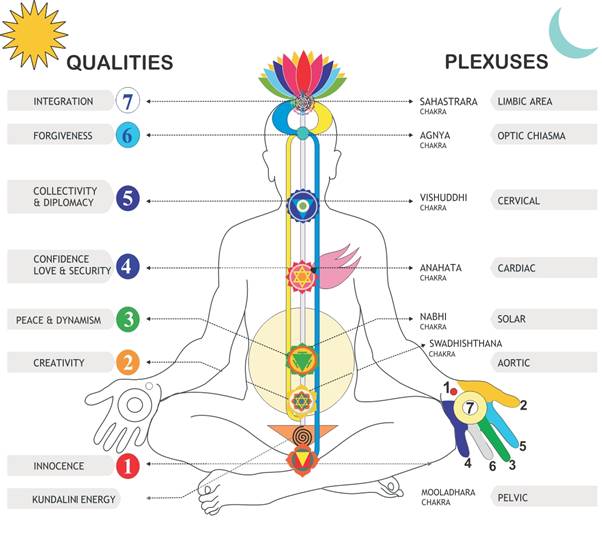
Says Kabir,
“O Servant of God, where do the Ida, Pingala and
Sushumna nadis go when the thread of life breaks.”
“One who holds the thread is beyond time, but where does
he live?
The thread is neither tied nor breaks,
Who is the master and who is the servant.
Only He knows his secret as he is the Eternal.”
“What is the warp and weft,
What are the threads from which the chadar (cloth) is woven?
Ida and Pingala are the warp and weft.
Sushumna are the threads from which the chadar is woven.
Eight are the Lotuses and ten are the spinning wheels.
Five are the elements and three the qualities of the chadar.
The Master required ten months to weave it and made it
well woven by hitting it and beating it.”
Kabir obviously refers to the subtle instrument of the body which the Kundalini weaves through the three channels, the system of chakras and the elements. After self realization he saw through the mumbo jumbo of God men. He rebuked the sadhus, monks, ascetics and all who made show off being God men;
“If God could be found by going naked then the beasts of the forest could have found him long ago.”
He decried ritualism, superstition, and fundamentalism, outwardly any one may pretend to be a saint, but,
“What will you gain by turning the beads of the rosary if you have not turned within?”
Rejecting all outward deliberations Kabir turned to the path of Sahaja Yoga or Sahaja Samadhi. The intensity of his bhakti spontaneously opened the petals of his heart and submerged him in the ecstasy of divine love.
“I have met him in my heart.
When a stream enters the Ganges,
It becomes the Ganges itself.
Kabir is lost in the Ganges.”
“I laugh each time I hear
The fish thirsts in water.
They seek Him Mathura and Benaras.
The musk deer’s fragrance is in its navel,
But he madly hunts it everywhere”
Kabir felt the need of a living Guru to deepen his Bhakti. He tried to approach the most renowned master, a vaishnavite Brahmin (Devotee of Lord Vishnu) named Ramanand who lived in Varanasi. There was no way that a Brahmin would accept a disciple from such a low caste. But Kabir was not deterred and devised a plan. Early in the morning, as Ramanand stepped down the Ganges embankment to bathe, Kabir lay flat on the steps. As Ramanand accidentally stepped on him, he cried out ‘Ram Ram.’ Kabir took this to be the initiation given by his Guru.
Kabir took Rama as his mantra, meaning the Ultimate allpervading Power of Divine Love. His pure desire for God was so ardent; nothing could hold him back!
“I have neither a roof nor a hut nor a house or a village.
If God asks, ‘who are you?’
I have neither name nor caste,
Thy Name alone, O Hari, is suffice.”
Kabir found that mental seeking recoiled in the play of the mind. Then how to go beyond the mental process?
“O friend, Kabir is lost in his search,
When the drop is lost in the ocean,
How can it be found?”
His guru pointed to his heart; God is the all Pervading Power of Love, and hence can be found through his attribute of love. The seeker must possess this quality otherwise how will he recognize Him. This is how the host of seekers, Gnyaneshwar, Eknath, Tukaram, Ramdas, Gora Kumbhar, Muktabai, etc found
Him.
Kabir found bhakti to be the easiest path to God. But bhakti cannot be qualified. Lord Krishna states in the Geeta it should be ‘Ananya Bhakti,‘ i.e. where there is no other, where there is total surrender and no other motive but the pure desire for God. As the love for the beloved, drenches the heart, likewise, the love for God comes from surrender. In that surrender there is no other, the soul merges with the universal soul, both become one.
Surrender comes from fervor devotion and pure love for God.
That love cannot be rationalized. It eludes all description- ‘
“It is neither human nor Divine,
It is not the Holy one demanding service,
It is neither a yogi nor an angel,
It is neither a householder nor an ascetic,
It is neither a Hindu nor a Muslim,
None saw it being born or die.”
Kabir ‘wakes and weeps, and suffers pangs of separation from his beloved God. He entreats the Lord not to desert him. His love for the Lord is very intimate;
“Listen to me O friend,
He knows Him who loves
If you feel not the pangs of love
It is vain to adorn your body.”
Bhakti necessarily implies the presence of a personality to whom it is addressed. For the unenlightened seeker, it is impossible to establish this rapport with an impersonal God. The bhakti has to be to a divine personality, who is an incarnation, otherwise the seeker is deceived. No doubt through vibratory
awareness of Shri Mataji Nirmala Devi it is possible to discern the milk from the water;
“They who separate the milk from water,
Says Kabir are my devotees.
They only will escape in whose heart is discernment.”
Under Sufi influence, Kabir’s poetry assumed a deep penetrating fervor, in which worship became love. The love thrills with joy, and the sufi crescendos into mad exultation of dancing. Perhaps such an ecstasy spells the dance of Shiva, in which his Shakti separates to celebrate her own creation. The desire to create is propelled by that inner joy. That ecstasy found expression in the exuberance of magnificent temples, mosques and cathedrals. The love of God dissolves into what the Sufis call ‘marifat’ (gnosis) – the mystical knowledge of God. It is a state of enlightened bhakti. In blind bhakti, one can be deceived but in enlightened bhakti, one becomes a part and parcel of the All Pervading Power of Divine Love, where there is no other, and the Divine music sweetly flows through the hollow instrument. Dyed in the color of divine love the Sufi easily abides in the phenomenal world without taking on any other color.
“O friend, I do not know
If my heart lies with my beloved (God)
Or my beloved resides in me.”
The wine of His love consumes all doubts and insecurities. The individuality merges into the consciousness of God’s love. There is no thought of reward; only trust in God and Love of
God. Kabir recommends that the novice should keep the company of saints to strengthen his bhakti and dispel doubts.
Bhakti can be deepened by listening to saints (shravanam), devotional singing (bhajans), remembering the Lord’s name, worshipping, adoring, saluting, serving, befriending and selfdedication to God.
“Even the sinner Ajmail, Gaja and Ganika crossed the ocean of the world by taking the name of the Lord.”
Manifest or unmanifest:, God is a living reality. For Kabir God was as personal as a bride or a groom;
“A newlywed bride sings marriage songs,
My husband Raja Ram has come.”
“O how can I explain that secret word?
How can I say He is like this or that,
If I say He is within me, the outer world blushes,
If I say He is outside, it is falsehood.
For Him the inner and outer worlds,
The conscious and the unconscious, are indivisible.
He is neither revealed nor hidden,
There are no words that can describe him.”
The ruler of Delhi, King Ibrahim Ibn Adham was greatly impressed by Kabir. He abdicated his throne to become his disciple. He made offerings of camels, gold and silver, but Kabir shunned them and asked him to follow the life of an ordinary householder following the normal manual chores before he could be initiated.
The King diligently carried out the instructions. Ten years passed. Finally Kabir’s wife Loi took pity on him and begged Kabir to initiate him. Kabir relented, on the condition that she should test him under his instructions. The following morning Kabir directed her to throw a bucket of dirty water on the king as
he passed under her window. The king indignantly shouted, “If you were in my kingdom you would have known.” Obviously he – the king, had not yet overcome the ego of his kingship. After two years Kabir informed Loi that the time was ripe to test the king again. This time the king received the bucket of water with great humility exclaiming, “I am even dirtier than this water, you have indeed blessed me.” The next day Kabir initiated him.
Kabir devised clever methods of playing tricks with the ego. He realized that human beings were blinded by their ego, and therefore could not see the reality. The play of the ego created an illusion or maya which led to the feeling of an individual identity separate from the all-pervading Power of Divine love. He described maya as, “a maiden who entices the world with its attraction and stands between the soul and universal soul. The vessel is in the water and the water is in the vessel. When the vessel is broken the water inside and outside becomes one. In the same way when the seeker breaks through the illusion or maya, he realizes his unity with the whole.”
“Maya is like a female thief who steals (Human Beings)
And sells in the mart (world)
But She cannot cheat Kabir who has caught her red handed.”
Like the moth in his flight towards the lamp is pierced with maya or hallucination, similarly maya is a super-imposition of illusion and therefore ignorance. Ignorance by its nature is transitory and cannot withstand the light of truth. When the seeker establishes his self-realization through Sahaja Yoga then
the Kundalini enlightens the brain and dispels the darkness.
Hence Kabir realized the futility of fighting the ego; if the ego is attacked then it forms ripples of reaction causing another polarity. Instead he chose to make fun of it;
“My swine is tied outside the house but yours is living inside you.”
“They search heaven, but do not find that which will take their pride away.”
The vibrations that emit from a realized soul are of absolute purity as they are the paramchaitanya, what Christ called the cool wind of the Holy Ghost. These bear the sterling quality of a mirror that reflects whatever is impure or untruth. Thus against the light of vibrations, falsehood gets fully exposed. The theory of relativity or the grey zones of the mind cannot stand before the absolute truth. Without vibrations the Human brain cannot reflect the Absolute Truth, because it is under the control of the
ego and the super ego i.e. our conditionings and mental programming. The vibrations of the Kundalini dissolve the ego and the super ego, and lift the curtain of Maya. Thereafter, the human attention becomes free to reflect the reality.
Kabir did not distinguish between caste and creed, Hindu or Muslim. He never referred to himself as a Hindu or Muslim, but claimed a caste which has lower than all castes;
“Yogis look upon Gorakh,
Hindus chant the name of Ram,
Muslims call out to Allah,
But the God of Kabir pervades in every being.”
Kabir lashed out at the empty customs and funny rituals of both Hindus and Muslims saying;
“When the Guru is the blind, what can the disciples do?
The blind urge on the blind, both fall into the well.”
“All cry out ‘God God’
But of the God they have no knowledge.
Where will they rest at last?”
“What use is bathing if the mind is full of filth?
The fish lives ever in the water, yet never loses its smell.”
He stood outside the temples and the mosques to expose the pandits and the mullahs.
“Renounce the Vedas and the books, O Pandit, all these are fictions of the mind.”
This infuriated the priesthood. The Kazi filed false reports against him. When Kabir was summoned by the Emperor he arrived late, apologizing that he was held by a curious sight of camels passing through a street narrower than a needle’s eye;
“Countless camels can be contained in the space between Heaven and Earth.
All can be seen through the pupil of the eye which is smaller
than the eye of a needle.”
He was pardoned.
But it did not quell the ire of the Brahmins, and they concocted tales of his illicit relations with a woman. His hand and feet were tied and he was thrown into the Ganges. But the next morning he appeared floating on the river. The Emperor then ordered that he be trampled under an elephant. A lion
suddenly appeared out of the blue and intervened between the elephant and Kabir, and frightened the elephant away. When all attempts to kill Kabir failed, he was banished from Varanasi.
According to Hindu belief to die in Varanasi leads to salvation. In the evening of his life Kabir left Varanasi and set out for Maghar; “What difference is there between Varanasi and barren Maghar, if God be in the heart.”
As his end drew near, he wished to be alone. A few hours later when his disciples returned, he was gone. A dispute arose between the Hindu and Muslim disciples for his body. The Muslims wanted to bury the body whereas the Hindus wanted to cremate it. When they removed the shroud from his body only a
heap of flowers remained in place of his body. The flowers were equally shared between the quarreling groups, the Hindus cremated them and the Muslims buried them. It seems that even in death he tricked their ego.
“Death after death the whole world died,
But none took future thought
Each held by his own wisdom,
But the whole world died a slave.”
